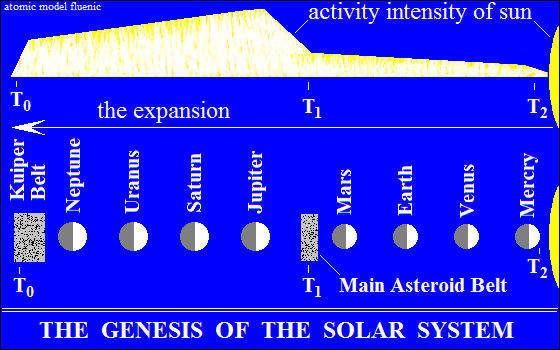Solar
system
(to know the world we live in)
The sun is a mature star and has a "family", a planetary system.
Sun activity produces and consumes hydrogen atoms continuously (double
torus oscillators).
Explicitly, planets and comets have emanated physically from the sun!
The configuration of the planetary system reflects the history of the
sun's activity
and the variability of intensity.
The sun and planets are electromagnets, but they have different structures:
the sun is a sphere of gas, hydrogen, and the planets are made up of the
atoms of the elements.
The interface of these structures is the solar chromosphere.
Interactions in the chromosome are violent electromagnetic reactions.
Chromosphere specific conditions are temperature, pressure, forces, accelerations,
all variables,
In the chromosphere are the nuclear reactions!
The chromosome receives hydrogen atoms
and emits the atoms of the elements (which produce the chromaticity).
The reaction products, the atoms of the elements, are dispersed in the
crown and the rotational speed.
The elements expelled in the crown also contain the impulse of rotation
speed - the centrifugal force.
A loose belt is formed around the sun, which circularly orbits the sun.
The elements is agglomerate chemically in larger or smaller granules
and centrifugal force push the orbit far away from the sun (reverse rain).
Geometry of the orbit guides the evolution of the belt
towards the state of the planet, comet, or asteroids.
The belt also supports the interaction of the galaxy, its orbit becoming
elliptical.
The movement of the substance into the elliptical orbit is at varied speed.
At the perihelion, the accelerated motion generates parallel currents,
centripetal force and radiations.
This process forms in the belt a spherical core (or more). The core grows
and becomes the head of a comet, the rest of the belt being the tail.
Centrifuge electromagnetic acceleration draws the substance from the solar
atmosphere, increases the temperature, the volume, and the nucleus becomes
the electromagnet - the planet.
The new planet is a sphere of incandescent gas, a "sun chick".
If at first the belt was passive, the planet now interacts and finds its
own orbit.
The Sun chick, with sun-like activity, generate hydrogen atoms and satellites.
Hydrogen will later turn into seas, oceans, ice.
The planets continue to receive particles emitted by the sun (meteorites
and "cosmic radiation"),
the mass increases and
the orbits expand.
This interpretation identifies in the planetary system two landmarks memorized
in rocks that can reconstitute the temporal scale of the successive birth
of each planet.
The first landmark, T0, is the start time
when the sun's activity invades the crown,
with the atoms of the elements and forms the Kuiper belt, then they form
the big planets.
The gravel from Kuiper belt conserve the first elements synthesized in
the solar chromosphere.
The second landmark, T1, is memorized in
the main belt rocks between Jupiter and Mars
and signifies half the process of forming the planetary system.
<< But, there is an even simpler method of determining the birth
of the solar system.
The notion of time is the measure of the evolution of matter, of "carbon".
The evolution of the solar system is exactly the "journey" of
the Kuiper belt.
So the distance from Kuiper to the sun is the measure of evolution –
the time.
The same reasoning also applies to galaxies. If the universe is a sphere,

